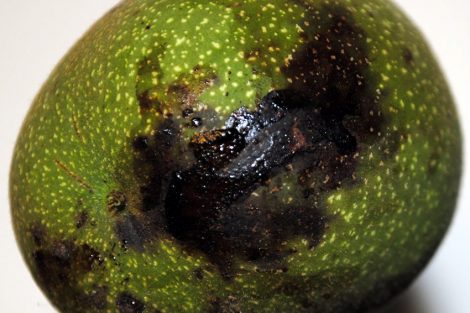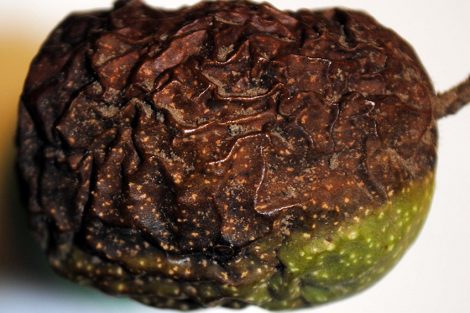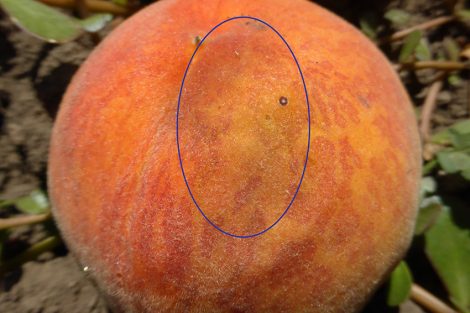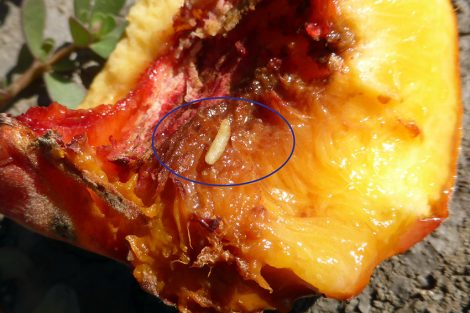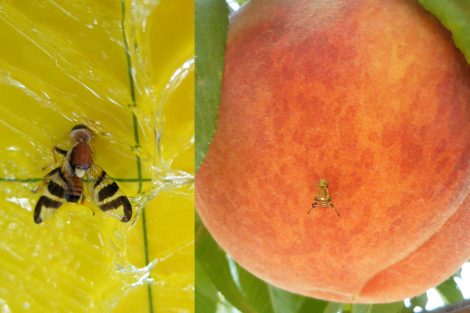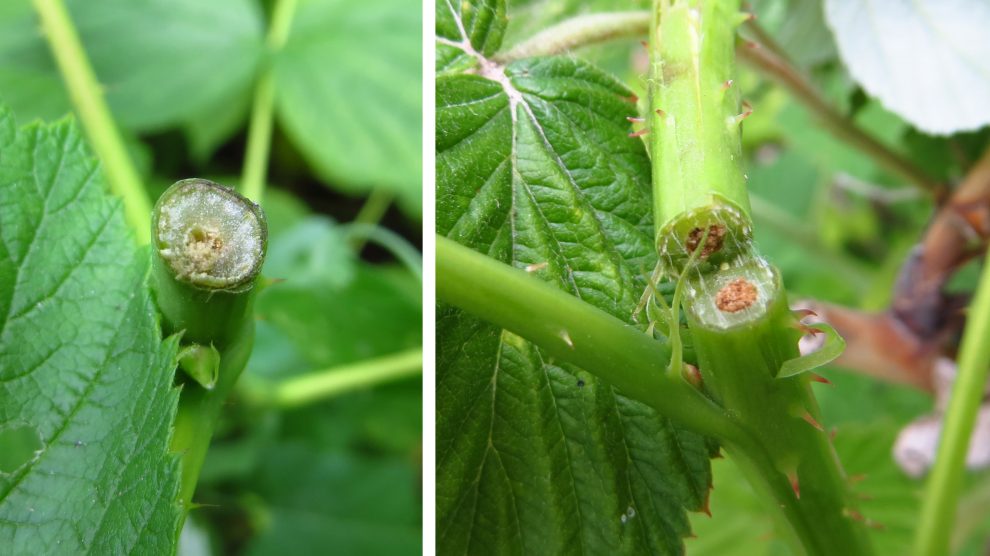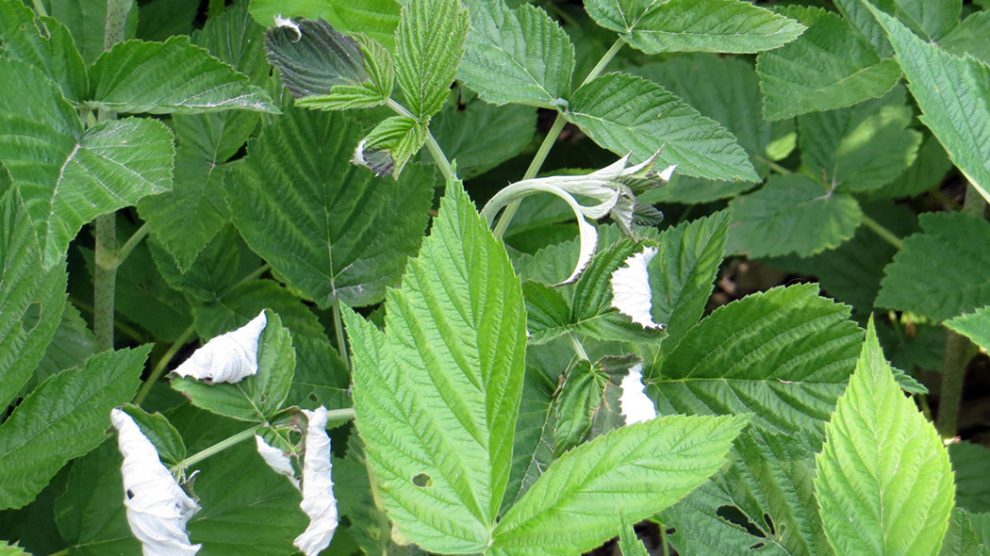In this Issue
- Codling Moth (apple/pear): updated spray dates table for codling moth
- Assessing codling moth injury
- Walnut Husk Fly (apricot, peach/nectarine, walnut): treatment time coming up
- Peach Twig Borer (apricot, peach/nectarine): updated spray dates table for peach twig borer
- Western Cherry Fruit Fly (cherry): check label of product you are using on sweet cherry for length of time to harvest (PHI)
- Raspberry Horntail: prune out wilted tops
APPLE, PEAR
Codling Moth
Note the time gap between end of first generation and start of second generation (on the table in the link below)
View a pdf of the spray timing table. Be sure to read the instructions at the top of the page, for how to read the table.
Codling moth in most sites will end the first generation egg hatch in late June to early July. Between the end of the first generation and start of the second generation, there is no worry of fruits becoming infested, so no need to have insecticide protection during this time. For the second generation, apply your next spray, or if you can tolerate higher injury or have a low population, apply your next spray at the start of “second generation peak egg hatch”. And then from there on, you should continue to protect your apple or pear fruit until harvest or September 15, whichever is earliest.
Note that there are restrictions for some insecticides on how many times it may be used (check your label). We recommend switching to a product with a different active ingredient for the second generation treatment. See the post from May 11 for a listing of products (you’ll need to scroll down once the page opens).
Treatment
- See this post for spray options for backyard growers (after the page loads, scroll down to Codling Moth table).
- Options for commercial growers.
Assessing Codling Moth Injury
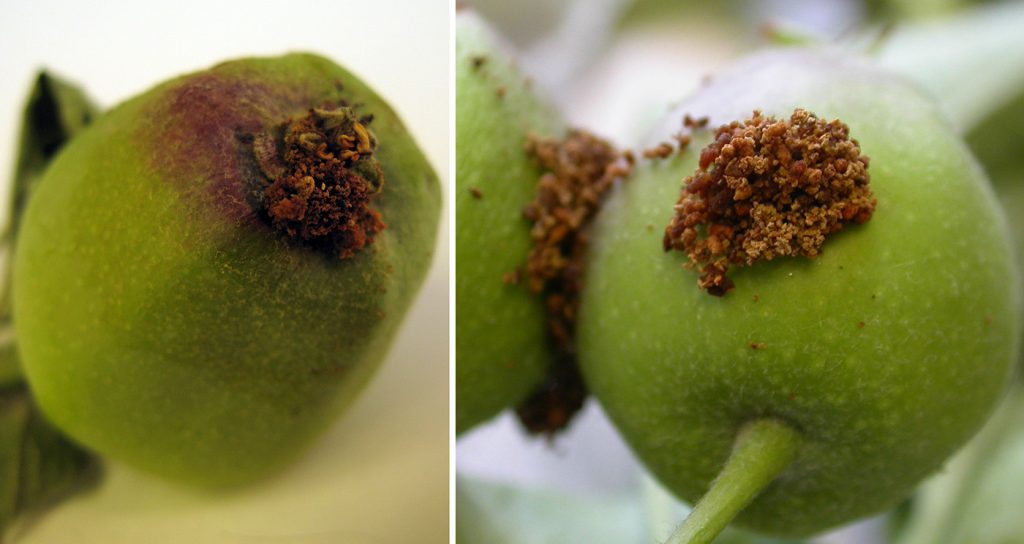
The end of the first generation egg hatch is a great time to assess your codling moth control by inspecting fruit for damage.
Commercial orchards should examine 5-10% of the fruit, and residential growers should check as many fruits as possible. Do not neglect fruit at the top of the tree where sprays may not have reached, or where residual insecticide may have broken down more quickly due to higher UV exposure.
A successful codling moth entry will show frass (sawdust-like excrement) pushed out of the apple at the entry hole. Most first generation entries are through the calyx end because, while fruit is still firm, it is easier for the larvae to enter at that location. Although not as common, side entries can also be found now, usually where two fruit touch or where leaves touch the fruit.
If you are finding a lot of damage, evaluate your management program to improve control for the second generation. Consider the material used, the spraying method, and the length of time between treatments. If you cut into the fruit to look for the larva inside, you can sometimes tell when your control failed.
- Large larvae or no larvae: The entry occurred approximately near the beginning of egg-hatch.
- Medium-sized larvae (1/3-2/3-inch long): Entry occurred at the early to mid egg-hatch period (early June)
- Small larvae: Entry occurred toward the end of the generation.
PEACH/NECTARINE, APRICOT, PLUM
Walnut Husk Fly
Hosts include nuts of walnuts and fruits of peach and apricot; emergence begins early July
Walnut husk flies will start to emerge throughout the Wasatch Front in early July, and in cooler areas, in mid-July. Just like cherry fruit fly, the husk fly overwinters as pupae in the soil, emerging as flies in mid-summer to lay eggs. The peak emergence period occurs about a month after first emergence. There is a single generation per year.
Apricots, peaches, and walnuts (black, Japanese, and English) are all hosts for the husk fly. For fruits, the flies prefer them when they start to get soft, so if you found maggots in your fruits last year, count on treating this year.
In walnuts, the maggots do not damage walnut meat directly. Instead, they feed on the husk which causes hull removal difficult, and black staining of the nutshell. Maggots feed on the husk for 3 to 5 weeks and then drop to the soil to pupate.
Non-chemical Treatment (walnuts)
- Like cherry fruit fly, populations of walnut husk fly can be reduced by placing landscape fabric under the tree canopy in late summer to prevent larvae from entering the soil.
- Remove all walnuts that fall to the ground.
- To make husk removal easier, store infested nuts in a damp burlap bag for 2-3 days.
Treatment
The primary option for both commercial and backyard walnut trees is the organic product, spinosad (Captain Jack’s, Gardens Alive Bull’s Eye, Monterey, Entrust, Success), which is applied every 7 days. Make sure you cover the entire tree.
Another option is using a bait with spinosad. The bait attracts the adult flies to feed on the product, and the spinosad kills the flies. GF-120 is a prepared bait, but is only sold in gallon-sized containers for at least $100. Backyard growers could consider mixing a bait solution of the spinosad concentrate with about 4 to 6 tablespoons of molasses per gallon of water applied.
The GF-120 or homemade spray mix does not need to cover the entire tree. Instead, it should be applied as evenly spaced, large droplets.
For treatment of husk fly in apricots or peach, sprays for peach twig borer will also target walnut husk fly
Peach Twig Borer
First generation egg hatch will be ending soon in certain locations
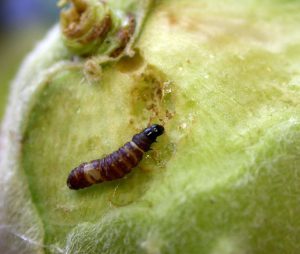
After fruit softens, twig borer larvae will enter the fruit to feed. View a pdf of the spray timing table.
The end of the first generation of peach twig borer egg-laying will occur soon, with egg hatch for the second generation starting in mid to late July. Where this insect is a problem, the second generation is more devastating because the larvae will attack the fruit once it starts to soften.
Treatment
- Residential growers can use the same product for codling moth (apple, pear), or see this table from May 11 (scroll down after the page opens) for a list of options.
- Commercial growers that will be harvesting apricots will need to apply sprays that will protect the fruit to harvest. Some options that have a shorter pre-harvest interval are Assail, Belt, and Intrepid (7-day PHI) or Exirel or Danitol (3-day PHI), or an organic such as azadirachtin (0-day PHI).
Greater Peachtree Borer
We provided the starting treatment dates for various locations in the June 6 advisory.
Aside from insecticides, please also note the other ways to prevent attack:
- Remove all weeds, grass, and excess soil from around the base of the tree. Heat and dryness reduce the survival of eggs and larvae. In addition, this will help the spray to cover the entire trunk and penetrate the soil to the upper crown and roots.
- Avoid mechanical and rodent-caused injuries to trunks.
- Keep trees healthy with optimal nutrition and irrigation.
CHERRY
Western Cherry Fruit Fly
Be mindful of pre-harvest intervals
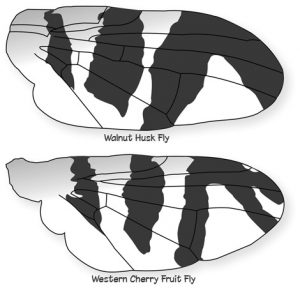
Most sweet cherries (where they survived the spring frost) are ripening, with tart cherry harvest to occur in mid-July. If a treatment for cherry fruit fly is needed close to harvest, select a product with a short pre-harvest interval, such as Sevin (carbaryl) or Malathion (both 3 days), or GF-120 (1 day).
Commercial growers may choose to use Admire Pro (or generic) for the last spray (7 day PHI) because it penetrates into the fruit slightly to target any larvae inside. Keep in mind, though, that Admire Pro can encourage spider mites.
Treatment Options – Backyard Growers
Conventional:
- Malathion (malathion): pre-harvest interval is 3 days
- Garden Tech Sevin (zeta-cyfluthrin); pre-harvest interval is 14 days
- Bonide Fruit Tree Spray (carbaryl): pre-harvest interval is 14 days
- Bonide Fruit Tree Guard (lambda-cyhalothrin): pre-harvest interval is 14 days
- Spectracide Triazicide (gamma-cyhalothrin): pre-harvest interval is 14 days
Organic:
- Fertilome / Gardens Alive / Bull’s Eye / Monterey (spinosad): pre-harvest interval is 7 days
- Safer BioNEEM (azadirachtin): every 7 to 10 days; pre-harvest interval is 0 days
Treatment – Commercial Growers
- Commercial growers, click here
SMALL FRUITS
Raspberry Horntail
Prune out wilted tops
Larvae of the raspberry horntail feed in the upper portion of canes, causing top-wilting. Damage has been visible for a few weeks now.
Now is the time to prune out these wilted portions of the canes and destroy the prunings. This will help to reduce the horntail population in your area. When pruning, be sure that you get the white larva inside the stem. It may be farther down the cane than you think. To get a feel for where the larvae are feeding, slice a few cut stems vertically to locate the single larva inside.
Where there is no borer, the pith will be creamy-white. A pith with loose brown material will indicate borer activity.

